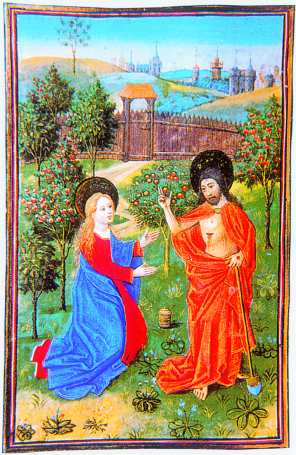| EASTER SUNDAY 
PETER, WITNESS OF THE RESURRECTION Historical and Liturgical Notes 1. In the twelfth century, the Bishop of Rome, following an ancient tradition, would pause in prayer at the Oratory of Saint Lawrence in the Lateran, nowadays the Shrine of the Holy Stairs, before setting out in procession from Saint John Lateran to Saint Mary Major, where he would chant the Solemn Mass of Easter Morning. The Oratory, still known as the Sancta Sanctorum, was considered one of the most sacred places in Rome. A celebrated relic of the Holy Cross was venerated there and then, as now, the Shrine housed the Acheiropita (not painted by human hands) icon of the Saviour. 2. The icon, probably brought to Rome from the East, was already mentioned in the Liber Pontificalis under the entry for Pope Stephen III (752-757). A full representation of the enthroned Saviour, it was painted on cloth applied to a wooden tablet measuring approximately 1.52 m. by 70 cm. The icon has been frequently restored, most recently in 1995-1996. The only part presently visible is the Face of the Lord painted on a silken cloth superimposed upon the original. The rest of the icon is covered by a sheet of silver. 3. The cult of the icon of the Most Holy Saviour, unlike that of the Veronica veil kept in the Vatican Basilica or other ancient Roman icons, was the only one to become part of the official celebrations of the Roman Liturgy. This is evident from the Liber Politicus (Ordo Romanus XI), a ceremonial book written between 1143-1144, and the Liber Censuum Romanae Ecclesiae (Ordo Romanus XII), compiled about 1192 by Cencius Camerarius, the future Pope Honorius III. These ceremonial books not only show that a procession with the Acheiropita took place on the night of the Assumption, but also that the icon was venerated during Holy Week. 4. On Easter morning, the Pope, vested in pontificals, entered the Sancta Sanctorum, opened the small silver doors covering the feet of the icon (the doors are still sealed) and kissed the feet three times. He then chanted the versicle: Surrexit Dominus de sepulchro, alleluia, to which the assembly responded: Qui pro nobis pependit in ligno, alleluia. The Cross, which had bee removed on Good Friday, was then placed on the altar for the Popes veneration. After the Pope, the members of the papal entourage venerated the icon and the Cross and then approached the Supreme Pontiff for the kiss of peace. The Pope gave the sign of peace reciting the versicle: Surrexit Dominus vere, to which each person responded: Et apparuit Simoni. Meanwhile the choir chanted a series of antiphons. Following these rites the papal procession was formed along the Via Merulana while the Pope was informed by a notary of the Baptisms which had been celebrated the previous night. When the Apostolic See moved to Avignon, the rite of the Resurrexit fell into disuse. With the return of the Popes to Rome, the Easter statio was transferred to the Basilica of Saint Peter. 5. The basis and the authentic significance of these ritual sequences can be found in the words of the Gospel of Luke which describe Peters amazement at seeing the empty tomb and the testimony of the Eleven that the Lord was truly risen and had appeared to Simon (cf. Lk 24:12,34; Jn 20:3-10). The appearance of the Risen Lord to Peter and to the other witnesses is the theological foundation of the Churchs Easter faith (cf. Acts 1:21-22; 1 Cor 15:3-6). The Bishop of Rome, the Successor of Peter, likewise meets the Risen Lord in the icon of the Most Holy Saviour and, after the solemn Easter proclamation of the previous nights Vigil, he becomes on Easter Day the «first» witness to all the Church of the Gospel of the Lords Resurrection. 6. As the Church celebrates Easter during the Great Jubilee of the Year 2000, she rejoices and gives thanks for the two thousand years which have passed since the Incarnation of the Word and for the Redemption accomplished by Christ through his Death and Resurrection (cf. Incarnationis Mysterium, 6) and she is confirmed in her faith in the Risen Lord by the Successor of Peter. The Bishop of Rome, having proclaimed the Lords Resurrection at the Easter Vigil, now bears authoritative witness to it Urbi et Orbi, before the City and before the world. In the spirit of the liturgical reform of the Second Vatican Council, it seemed fitting that the ancient rite of the Popes witness before the icon of the Most Holy Saviour should be restored and inserted, with appropriate adaptions, in the introductory rites of the festive liturgy of Easter Day. Surrexit Dominus vere, alleluia
Et apparuit Simoni, alleluia + Piero Marini
Titular Bishop of Martirano
Master of the Liturgical Celebrations
of the Supreme Pontiff |



